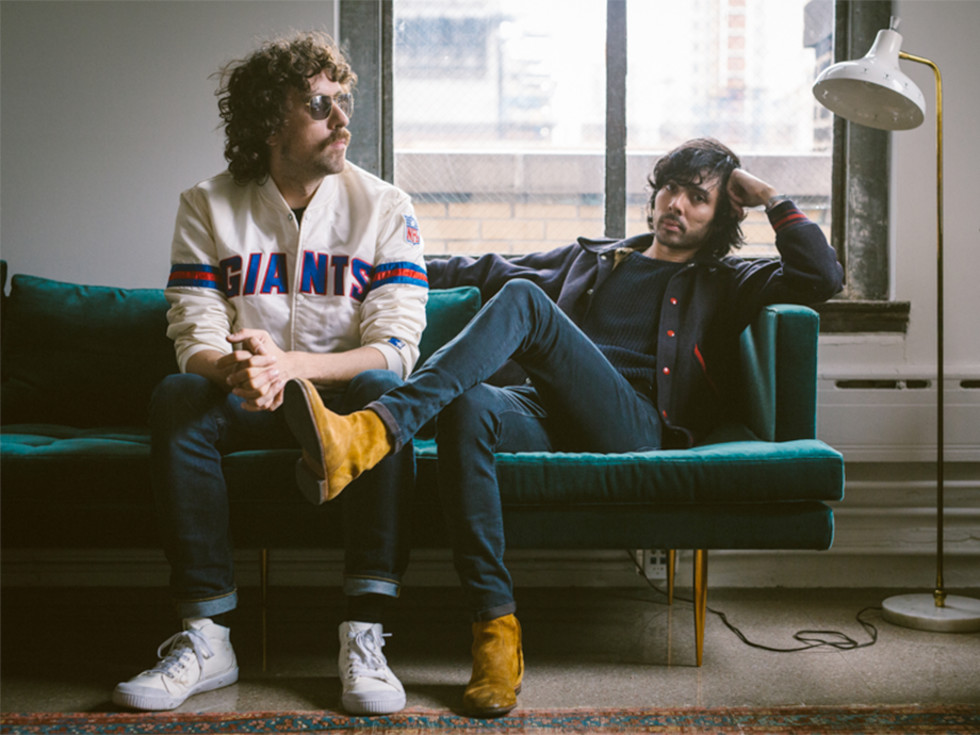Legendary French Duo Justice Talk Pleasure, Creative Destruction and Their New LP
Playboy, Novemeber 16, 2016
Stories behind the new record along with some of the visual work and process behind the band.

| By Kevin Shea Adams Photography by Kevin Shea Adams |
Xavier de Rosnay and Gaspard Augé, aka French electronic music duo Justice, are seated together on a high terrace in midtown Manhattan, talking quietly above the din of the city on a sickly warm November morning. It’s the day after their first show in New York since the announcement of their new album, Woman, out this Friday, and some exotic bird has perched on the building’s ledge, singing alien songs that we unanimously allow to interrupt our chat. It’s 3 o’clock in the afternoon, but last night seems like it just ended–some hazy, radiant dream of a packed dance floor at a secret midnight set somewhere down below. De Rosnay seems tranquil and even well-rested as he describes the feelings and craft that went into the latest LP—their third studio album since the unforgettable hit “D.A.N.C.E.” filled iPods across the globe back in 2007.
Woman, with its relatively bright and simple disco feel, breaks from the dark, tricked-out dance-floor monsters Justice is notorious for (consider the drop on “Genesis,” which still burns clubs to the ground 10 years later). But for all its apparent simplicity and stripped-down warmth, the album is as meticulously conceptualized and designed as anything else bearing the Justice cross.
Here, de Rosnay, who does the vast majority of the talking, tells some of the stories behind the new record along with some of the visual work and process behind the band.

There’s a line that stuck with me from the album’s second track, “Pleasure”: “Use imagination as a destination.” The choir singing that line seems to capture the spirit of this album.
The whole mentality behind this record was to make something pleasurable and not fight against it. It’s funny because the hook there that you are talking about—from the moment [Morgan Phalen] sang it, we were just dancing around the studio, and then about five minutes later we were thinking, Wait, isn’t that a bit corny? Isn’t it a bit too easy? It was one of the first tracks we wrote for the record, and we had this talk: It feels good and it’s cool and simple, let’s keep it. Maybe it’s something we would have fought against a bit on previous albums, when we would find hooks like this and we might begin to maybe overthink them–can we make it more complicated or more intelligent? But I think the biggest directing line for this record was actually to not fight things, and to indulge in the pleasure of making things that can touch people and that touch us as we make it.
It’s definitely easy to overthink things in electronic music. You’re not like a typical band in a garage where things happen more spontaneously and collectively.
It’s a long process and we try a lot of things and we always feel that a song is not finished unless you find all the possibilities and then can pick what you want to do. But you’re right: It is very easy to lose yourself. Making electronic music is like being a rock band, but you are all the members at the same time, and they are all puppets and you can make them do whatever you want them to do, and it’s endless. But that’s why it’s good to be two.
Have your ways of working together stayed the same over the years?
No. When we started we didn’t have a computer. “We Are Your Friends” was made with a manual sequencer, sampler, 16-channel mixer, one synth, one piano expander and a CD burner. Then we bought our first computer in 2005 and started to understand what digital could bring. Our setup changes all the time, but one thing we remember from the time when we didn’t have a computer was we couldn’t have 20 instruments playing together. You were limited by the amount of things you could synchronize at the same time, and when you have only two or three instruments in a song you have to get the most out of them. A lot of tracks we made pre-2007 were made this way: One synthesizer would do the low things, one would do the high things and one would do the chords, and then everything has to bounce and change all the time. For some of the tracks on Woman, “Safe and Sound” is three instruments, “Pleasure” is three instruments. It’s very fun when you don’t have many things and you have to try to get the most out of them. This is something that the Strokes are very good at.
I remember Julian Casablancas referencing the Doors as a big musical influence in exactly this way: Every part can always be heard and has this independence, but each part matters just as much as any other.
The Strokes are so intelligent as a band. If you don’t pay attention it’s difficult to know who is doing what, and then when you start to listen closer it’s fucking crazy because most of these things don’t make sense on their own. It’s just the way they intertwine, and things are always much more simple than they seem to be. We have a lot of adoration for them.

Last night’s DJ set felt a lot like being in the video for your new single, “Alakazam!” Was that actually compiled from audience cell phone footage?
The footage is not found. There’s a production company we work with a lot in France called Iconoclast and we called them and said we wanted to capture this moment. They sent 20 or 25 people to London with iPhones because we wanted it to have this YouTube, lo-fidelity quality. I don’t know if you noticed this, but every time you watch a live show, the videos that people take from the crowd are 10 times better than the professional ones, and this is what we wanted. Then the editor had this amazing idea of having the verses use the sound of the venue from the audio on the cell phones and when the chorus enters you have the sound of the real track. We are happy just to be exploring this idea again of making very low-budget videos. There are ideas that you have and sometimes you need a big budget to do them, but once in a while you have this thing you can do for almost no money and it works.

You guys seem to have a special mastery with images and somehow are able to get your work out there in this “new media landscape” in a way that still shows up.
Well, we’re almost absent from social networks, so it’s not something that we really know how to orchestrate, but I think with the technique for making images, we like it and we used to be graphic designers before and we love images in general and have very specific tastes. The video for “Civilization” is a good example. We had so many people working on it for so long and every hair on every bison was animated and there were so many details, but when the video was finished we were looking at it and we liked it but we didn’t like the rendering of it. So we asked the director to film a beta monitor playing it just to have a bit of air and all these little glitches that you can’t create with a computer. It’s a bit the same thing with music: You write a tune and then you mix it, but it only feels right when you manage to reach this texture that you want to feel. It’s these little details that matter. The last two percent are the most important.
Augé: The greatest difficulty we encounter working with people who make images is to have them go into that kind of destructive process. For us it’s never destructive enough or processed enough, and so they have to destroy their own creation.
The album artwork for Woman, like your other records, somehow feels like a real LP even when it’s just a tiny image on a screen.
The cover is a long story. I met a guy who works in a restaurant who is a sous chef and he’s responsible for fermentation experiments. Most of the time during the day he is in a lab, just making things, and we saw a picture that he made of something fermenting that had this kind of color, like petroleum, where you have all these reflections. And we thought the same thing at the same moment: We would use this to make our album cover. So then the challenge was to make an album cover from a cell phone picture and so we asked our friend Charlotte Delarue, a graphic designer that I’ve known for 15 years from school, to make the cover based on this image. She had to make a mock-up with the image and our cross and that took us about three or four weeks just to get the right details and shapes and everything. Once she had it, she hired a digital painter to paint this design–this genius guy, I don’t know how he does it–and then we hired a museum photographer to take a picture of the print of this digital painting just to have this extra life and texture to it. So it was a four-step process, a photo of a digital painting based on an Instagram picture.
And the name of the album, Woman...
The main thought behind that was to find a powerful word, and this word is very powerful to us because we have always been surrounded by very strong female figures. And you know the symbol of justice is a woman. When we think of a woman, we think of this very powerful woman that originates life, because we all come from women.
Contact: info@kevinsheaadams.com
All images copyright 2025. No image may be used, mined, mulched or reproducedwithout express permission from the artist.
Logo illustration by Matt Huynh. Photo by Ella Rose Ledyard.
